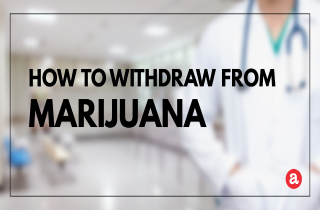Quitting marijuana can be very difficult for daily, chronic users. In order to withdraw from marijuana, it’s best to educate yourself so you’ll know what to expect and how to deal with problems that can occur. Read on for more about how to withdraw from marijuana and what to expect during marijuana withdrawal syndrome. Then, we invite your questions about marijuana withdrawal or finding marijuana addiction help in the comments section at the end.
When do you withdraw from marijuana?
Withdrawal from any drug occurs after physical dependence develops. The same is true for marijuana. Daily use of marijuana leads to physical dependence over the period of a few weeks. When you become physically dependent on marijuana, this means that marijuana withdrawal can occur when you drastically reduce doses of THC (the active ingredient in marijuana) or when you stop using marijuana completely.
How long to withdraw from marijuana?
The time it takes to withdraw from marijuana will generally be determined by your individual circumstances, particularly the length of time you’ve been using the drug. For instance, if you’ve been using marijuana everyday for several years, it will typically take you longer to withdraw from marijuana than if you’ve only been a casual user for a few months.
After you last use marijuana, withdrawal symptoms will usually occur within a day to three days. These symptoms can last anywhere from a week to a month.
Can I withdraw from marijuana at home?
Marijuana typically does not have any dangerous withdrawal symptoms like some other drugs. Therefore, you can usually withdraw from marijuana at home without any serious problems. However, enlisting the help of addiction specialists can help minimize the chances of a relapse and better equip you to deal with marijuana withdrawal symptoms.
Withdraw from marijuana symptoms
It’s likely that you’ll experience a number of different marijuana withdrawal symptoms when you stop using this drug. Some of the more common symptoms include:
- anxiety
- decreased appetite
- drug craving
- headache
- insomnia
- irritability
- restlessness
How to ease withdrawal symptoms from marijuana
Many withdrawal symptoms from marijuana can be treated at home. Oftentimes, it’s just a matter of changing some of your routines and habits. For instance, to help relieve anxiety and insomnia, eliminate caffeine and try to stay as relaxed as possible. Relaxation techniques, such as breathing exercises or even a regular exercise routine may be helpful for this. Headaches can be treated with over-the-counter pain medication, and nausea can be treated with over-the-counter stomach medication. Similarly, irritability or restlessness can be treated using awareness practices such as meditation.
Medications studied as possible treatments for marijuana withdrawal include those that alleviate symptoms of cannabis withdrawal, those that directly affect endogenous cannabinoid receptor function, and those that have shown efficacy in treatment of other drugs of abuse or psychiatric conditions. To day, buspirone is the only medication has shown efficacy for cannabis dependence in a controlled clinical trial. However, dronabinol and lithium may warrant further study.
How to withdraw From marijuana safely
Safety is not usually much of an issue when withdrawing from marijuana. However, it may be best to go through marijuana detox and withdrawal under medical supervision. There is less chance of a relapse when you withdraw from marijuana in a detox or clinical setting, and medical professionals will be able to help you if something should go wrong during your withdrawal.
The best Way to withdraw from marijuana
There is no one and only way to withdraw from marijuana. Typically, the best way to withdraw from marijuana will depend on you and your individual needs. Many people, though, find that the best way to quit using this drug is to taper their usage and gradually reduce the amount they use by a small amount each day or each week. This is often more successful than quitting cold turkey, and individuals that use this method will usually experience less intense withdrawal symptoms.
You should also try to stay away from marijuana completely while you’re trying to quit. This means get rid of all of your marijuana as well as all of your marijuana paraphernalia. Surround yourself with non-users and try to stay busy with activities in which you will be unable to use the drug. This eliminates temptation and helps make withdrawing from marijuana a bit easier.
How to deal with withdrawal from marijuana
Withdrawing from marijuana can be a touch time. If you’re ready to quit but need a little guidance, leave us a comment below. We’ll try our best to answer your questions and point you in the right direction.









Related Posts